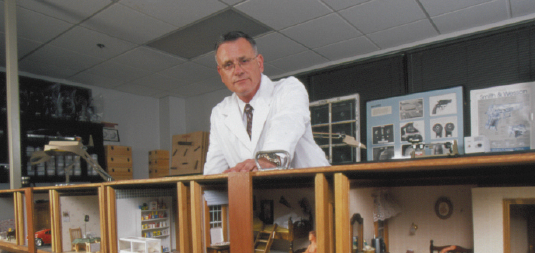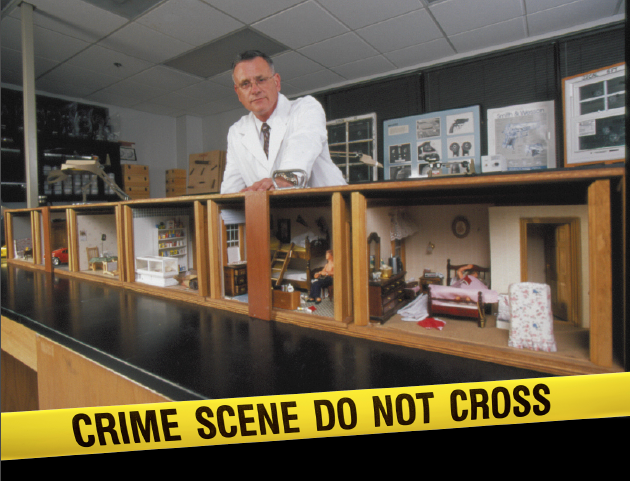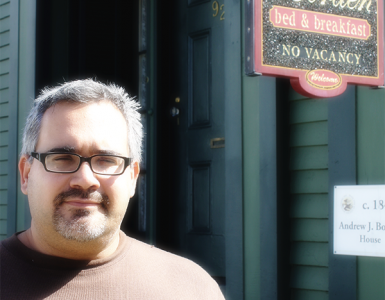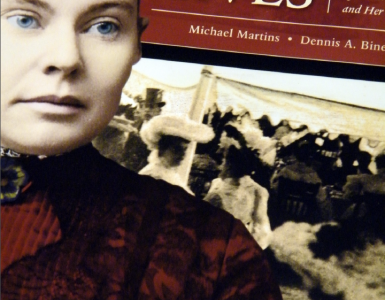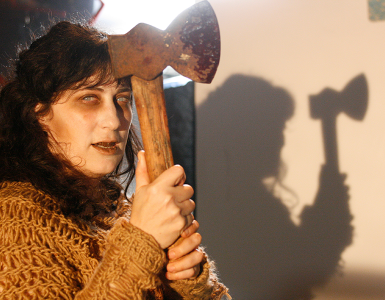by Stefani Koorey
First published in January/February, 2008, Volume 5, Issue 1, The Hatchet: Journal of Lizzie Borden Studies.
Tom Mauriello has over 34 years of professional experience in the criminal justice sciences. His academic career includes teaching, mentoring, and managing the Crime Laboratory for the University of Maryland at College Park, Department of Criminology and Criminal Justice. During his 30 years on the faculty, he has taught criminal justice administration, investigation, forensic sciences, and criminalistics. Tom is also a forensic sciences consultant, having appeared on ABC’s World News Tonight, The O’Reilly Factor, and MSNBC’s Lester Holt Live. His most notable commentaries were during the O.J. Simpson trial in 1994, the 2002 Washington sniper shootings, and as the forensic sciences investigator for the Discovery Channel’s 2004 documentary, Lizzie Borden Had an Axe.
Tom wrote the legal text Criminal Investigation Handbook: Strategy, Law and Science (LEXIS Publishing), now in its 18th release—used nationally as a guide for investigators, prosecutors, and defense attorneys. His second book, The Dollhouse Murders (2004), illustrates the use of six uniquely designed crime scene dioramas, created by Tom, in the crime scene investigation process.
Born and raised in Malden, Massachusetts, Tom resides with his wife and three children in the State of Maryland.
The Hatchet: Professor Mauriello, you use a fascinating tool in the classroom to teach your students about criminology and crime scene evidence. Could you tell us what inspired you to create dollhouses to use in your teaching?
Tom Mauriello: When I first created and began teaching my forensic sciences course at the University of Maryland @ College Park, I used to use a fully furnished residential type house on campus. I would set up a crime scene in the house for the students to examine, search for evidence, and process. As the student numbers quadrupled in size, the logistics for using the house got too difficult and time consuming to use. Therefore, I needed to look for an alternative for my students to get a practical view of conducting a crime scene investigation. I was working at the State of Maryland Medical Examiners office, where Frances Glessner’s Nutshell Dollhouses are on display. It was after viewing them that I got the idea to create my own dollhouses, Crime Scene Cases (dioramas) as I call them, and use them to take the place of the life size house that I was using on campus.
Hatchet: With last season’s C.S.I. and its focus on the meticulously recreated small scale crime scenes as a methodology of murder (the murderer literally left clues to the crimes in the miniatures for the investigators to find), do you think that small scale studies like the ones you use are coming into the fore in the study of criminology?
TM: The dioramas used on the C.S.I. series last year are exactly the same in size and depth as my dioramas. One could believe that they took the idea from my book, The Dollhouse Murders. Anyway, the trend really is to use two dimensional web-based software programs, rather than three dimensional dollhouses. The reason is not too many departments have crime laboratories to teach their forensic courses, and as you well know, there is a trend to deliver courses more online.
Hatchet: Have you had occasion to teach other professional criminologists your work so they also can include it in their teaching methodologies?
TM: Yes, I have. A colleague of mine on campus from the Life Sciences Department has been using all six of my dioramas to teach her summer forensic sciences workshop to high school students. I have been loaning them to her for the last 10 years or so. Her name is Dr. Kacie Thompson. Besides undergraduate students, I also use the dioramas to teach police officers and investigators in training.
Hatchet: In 2004, you participated as an expert, along with Tom Lange, in the Discovery Channel’s documentary Lizzie Borden Had an Axe. You are shown with a rather large dollhouse of the Borden house made to scale. Had you been using this model in the classroom for some time, or was it created for use in the movie?
TM: Morningstar Entertainment created the Borden dollhouse exclusively for the Lizzie Borden Had An Axe Discovery documentary. It was built by a stage designer.
Hatchet: If you have been using the Borden dollhouse in your classroom, could you tell us what effect it has had on the students and has it brought any of them closer to solving the crime? And in addition, what are their comments of the case following your use of this model in your classroom?
TM: Morningstar still has the Borden dollhouse, although I have been toying with the idea of asking them to donate it to UMCP for my use in class.
Hatchet: In another segment of the same documentary, you and Lange sprayed Luminol on the ceiling of the cellar, directly under the area on the first floor where Andrew Borden’s body lay more than 100 years ago. Your tests proved positive and were very much a highlight to the show. Pardon my novice question, but does the presence of blood evidence in this area of the house also mean that there is DNA in the floorboards there as well? Could it be extracted in any way and analyzed for type or genetic profiling?
TM: First, let me explain what was really accomplished using the luminol during the production of the documentary. The positive reaction of the luminol in the Borden house simply meant that blood or a number of other substances that cause a positive reaction to luminol was present. We never proved that the positive reactions in the basement of the house were in fact blood because Morningstar did not want to test the samples I collected to verify that they were blood. Whether we could have proven that it was blood and actually found DNA that was over 100 years old remains to be seen.
Hatchet: In 1992, Professor James Starrs attempted, without success, to gain permission to disinter the bodies of Andrew and Abby Borden and study them. In your opinion, is there merit in a reexamination of the bones of the victims after all this time and, further, is there anything new and/or substantive we can learn by such an investigation?
TM: Yes, I think so. It was never proven that the hatchet head found in the basement and presented at the trial was in fact the murder weapon. With today’s toolmark technology, I believe that could be proven once and for all. Comparing the trauma to the two skulls, at the location where it is believed the hatchet was used to strike the Bordens, against the edge of the hatchet could conclusively determine whether it was or was not the murder weapon. That would help substantiate Lizzie or someone in the house as the murderer. DNA/blood testing of the hatchet head would also do that. They would not let me place luminol or any other chemical on the hatchet when Tom and I examined it.
Hatchet: Do you have an opinion about the identity of the murderer(s) of Andrew and Abby Borden?
TM: Yes, and it is the same as my opinion on who killed Nicole Simpson and Ron Goldman. In 1892, Lizzie killed her parents and got away with it. In 1994, OJ Simpson killed his former wife and her friend and got away with it. Why? In both cases there was a lack of evidence preservation and basic investigative protocol used.
Hatchet: Do you think the Borden murder will ever be definitively solved?
TM: No. Time has realistically eliminated the ability to do that, and I don’t think the community of Fall River really wants the case solved.
Hatchet: What about the blood? Where did it go?
TM: At least in the case of the father’s death, this is what I believe happened—by the way, although this was explained by me during the filming of the documentary, it was never used. I believe that the father was sleeping (unlike what was demonstrated in the documentary, when the father woke up and opened his eyes) and Lizzie stood beside the wall in the dining room by the doorway entrance where the father was asleep on the couch. She wrapped her right arm with her father’s coat; struck him multiple times with the hatchet; the blood spattered on the wall where she was standing; and then she removed the bloody coat and placed it under her father’s bleeding head.
Hatchet: What about the noise factor mentioned in the documentary?
TM: Again, misinterpreted and incorrectly presented in the documentary. I believe Lizzie’s testimony was that she was ironing in the dining room when her stepmother was killed upstairs in the bedroom above where she would have been standing. The point I was trying to make was that Mrs. Borden, after being struck on the head and falling onto the floor, would have shaken the house and would have easily been heard. Lizzie stated she heard nothing. I grew up in a New England home similar in construction to the Borden home, and you hear every movement above you.
In the classroom, we tend to present material in a stove pipe fashion. The students learn the material independent of understanding how the information is used in it’s aggregate. I teach what I call “strategic investigations.” So, I present material in a manner so the students see the course of study as:
A “process” of activities conducted by multiple players in the field. (This is violated in the C.S.I. TV series where all the activities are done by the main characters. Therefore, I am NOT a fan of C.S.I.).
A series of actions taken to produce a specific output, the solution of a crime.
A means to understand and anticipate the needs, requirements, and expectations of all other players involved in the criminal investigation process.


